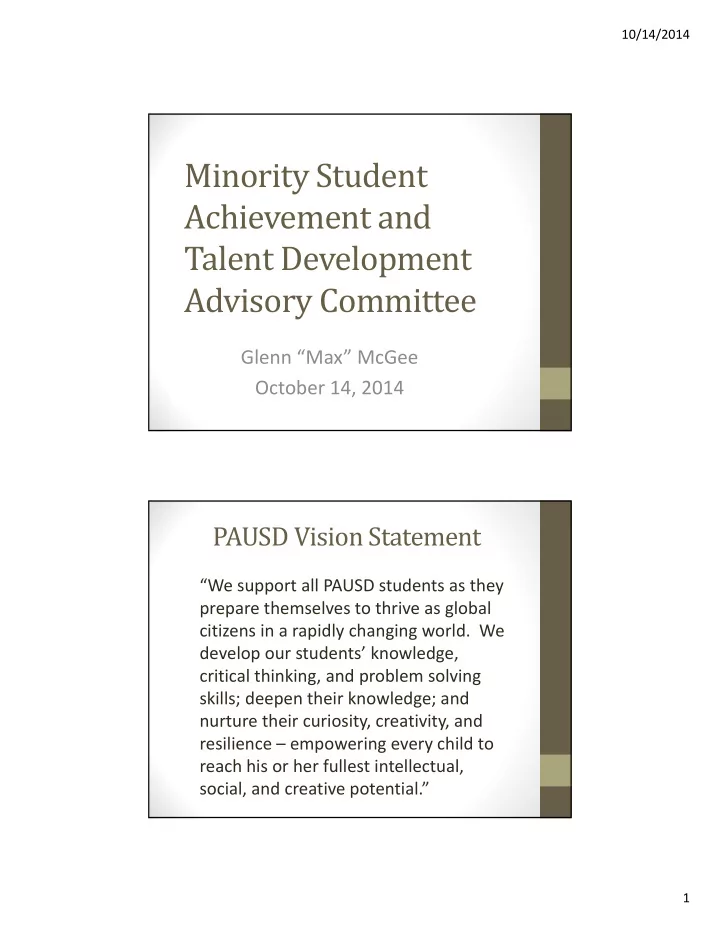

10/14/2014 Minority Student Achievement and Talent Development Advisory Committee Glenn “Max” McGee October 14, 2014 PAUSD Vision Statement “We support all PAUSD students as they prepare themselves to thrive as global citizens in a rapidly changing world. We develop our students’ knowledge, critical thinking, and problem solving skills; deepen their knowledge; and nurture their curiosity, creativity, and resilience – empowering every child to reach his or her fullest intellectual, social, and creative potential.” 1
10/14/2014 Focus Goal One To prepare students for a future that necessitates global collaboration and competition and cultivates support for a district ‐ wide culture that expects, advances, inspires, and promotes academic excellence, hard work, active engagement, and perseverance for every student. 2
10/14/2014 2012 ‐ 13 SARC Percentage Proficient Category HS 1 HS 2 HS 1 HS 2 ELA ELA Math Math Asian 90 93 88 94 White 91 89 71 78 Low SE African American Latino 2012 ‐ 13 SARC Percentage Proficient Category HS 1 HS 2 HS 1 HS 2 ELA ELA Math Math Asian 90 93 88 94 White 91 89 71 78 Low SE 43 34 28 30 African 59 38 24 23 American Latino 53 43 42 31 3
10/14/2014 From “The Achievement Trap” There are far fewer lower ‐ income students achieving at the highest levels than there should be, they disproportionately fall out of the high ‐ achieving group during elementary and high school, they rarely rise into the ranks of high achievers during those periods, and, perhaps most disturbingly, far too few ever graduate from college or go on to graduate school … Unless something is done, many more of America’s brightest lower ‐ income students will meet this same educational fate, robbing them of opportunity and our nation of a valuable resource . 4
10/14/2014 From “Mind the (Other) Gap” The highly visible national struggle to reverse poor achievement among low ‐ income students must be accompanied by a concerted effort to promote high achievement within the same population … The time is at hand for targeting public policies, private resources, and academic research to help these young strivers achieve excellence and rise as high educationally as their individual talents can take them. We Can Succeed! “Our experiences, along with observed experiences of other school districts, suggest that for school systems to succeed in closing achievement gaps they must: • Admit they have a problem and put the data that demonstrate the problem front and center in a form that can be understood easily. • Measure and report progress consistently. • Make the goal of eliminating or narrowing gaps a priority for everyone in the organization. • Distribute equitably resources directed toward achieving the goal. • Implement measures that focus on key variables early and consistently.” Gaining on the Gap: Changing Hearts, Minds, and Practice (2011), Rob Smith 5
10/14/2014 Learnings from MSAN • Another way that MSAN districts work to close gaps is by establishing clearly defined and measurable equity ‐ focused goals. Examples of these goals include: • A clearly articulated goal and process for increasing the number of students of color taking AP/Honors classes. • Strict focus on on ‐ grade level reading (mostly third grade, but also focused resources at fifth). • Strong induction programs for teachers to support their knowledge and practice of culturally responsive instruction. • Double dosing or other types of supports for success in Algebra I by the end of ninth grade. By partnering with high schools, we find students missing from the most rigorous classes and change their life trajectories. By identifying, enrolling, and supporting missing students in challenging college ‐ preparatory courses, we boost their academic motivation and achievement, and their likelihood of going to and graduating from college. “The issue of access to challenging high school coursework affects all students; however, low ‐ income, Latino, and Black students access AP and IB courses at the lowest rates. This ‘enrollment gap’ in advanced courses has been around for a long time – but educators … are finding ways to fully close that gap. By focusing on removing barriers for traditionally under ‐ represented students, these school leaders make outsized gains in access to challenging courses, college readiness, and the achievement gap.” 6
10/14/2014 Research on 90/90/90 Schools, “Golden Spike Schools, and other High Poverty, High Achieving Schools • Exceptional leaders • Extraordinary Teachers • Extended Learning Opportunities • Parental Engagement and Outreach • Early Learning and Literacy The Charge The purpose of this Advisory Committee is to prepare a set of strategic, evidence ‐ based recommendations that when implemented will enable the PAUSD community to assure that underrepresented minority students and other students from disadvantaged circumstances have the necessary opportunities, conditions, and supports that will empower and enable them to succeed as well as both realize and maximize their fullest intellectual, social, and creative potential. 7
Recommend
More recommend